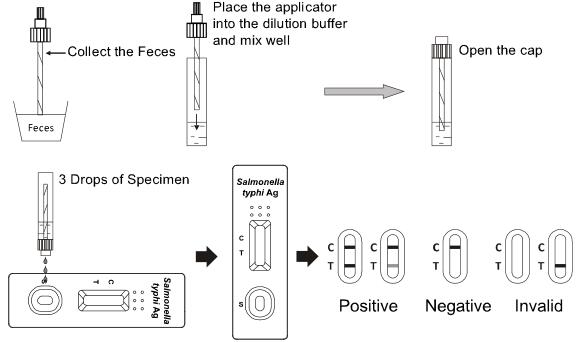Suite 33-01, 33rd Floor, Menara Keck Seng,
203, Jalan Bukit Bintang,
55100 Kuala Lumpur,
Malaysia.
| Previous | 81 / 112 | Next |
of typhoid fever1. The infection is acquired typically by ingestion. On reaching the gut, the bacilli attach themselves to the epithelial cells of the intestinal villi and penetrate to
the lamina and submucosa. They are then phagocytosed there by polymorphs and macrophages. The ability to resist intracellular killing and to multiply within these cells
is a measure of their virulence. They enter the mesenteric lymph nodes, where they multiply and, via the thoracic duct, enter the blood stream.
The S. typhi Antigen Rapid Test Cassette (Feces) is a rapid chromatographic immunoassay for the qualitative detection of Salmonella typhi antigens in human feces specimens, providing results in 5 minutes. The test utilizes antibodies specific for Salmonella typhi antigens to selectively detect S. typhi antigens in human feces.
¡¾DIRECTIONS FOR USE¡¿
Allow the test, specimen, buffer and/or controls to reach room temperature (15-30°C) prior to testing.
1. To collect fecal specimens: Collect sufficient quantity of feces (1-2 mL or 1-2 g) in a clean, dry specimen collection container to obtain maximum antigens (if present). Best results will be obtained if the assay is performed within 6 hours after collection. Specimen collected may be stored for 3 days at 2-8¡æ if not tested within 6 hours. For long term storage, specimens should be kept below -20¡æ.
2. To process fecal specimens:
• For Solid Specimens:
Unscrew the cap of the specimen collection tube£¬then randomly stab the specimen collection applicator into the fecal specimen in at least 3 different sites to collect
approximately 50mg of feces (equivalent to 1/4 of a pea). Do not scoop the fecal specimen.
• For Liquid Specimens:
Hold the dropper vertically, aspirate fecal specimens, and then transfer 2 drops (approximately 100μL) into the specimen collection tube containing the extraction buffer.
Tighten the cap onto the specimen collection tube, then shake the specimen collection tube vigorously to mix the specimen and the extraction buffer.
3. Bring the pouch to room temperature before opening it. Remove the test cassette from the foil pouch and use it within one hour. Best results will be obtained if the test is performed immediately after opening the foil pouch.
4. Hold the specimen collection tube upright and open the cap onto the specimen collection tube. Invert the specimen collection tube and transfer 3 full drops of the
extracted specimen (approximately 120μL) to the specimen well (S) of the test cassette, then start the timer. Avoid trapping air bubbles in the specimen well (S). See illustration below.
5. Read results at 5 minutes after dispensing the specimen. Do not read results after 15 minutes.
Note: If the specimen does not migrate (presence of particles), centrifuge the extracted specimens contained in the extraction buffer vial. Collect 120μL of supernatant, dispense into the specimen well (S) of a new test cassette and start a fresh following the instructions mentioned above.

|
Cat. No. |
Product Description |
Specimen |
Format |
Kit Size |
Cut-Off |
Status |
|
ISTY-602 |
Salmonella Typhi Antigen Rapid Test Cassette |
Feces |
Cassette |
25 T |
See Insert |
CE |